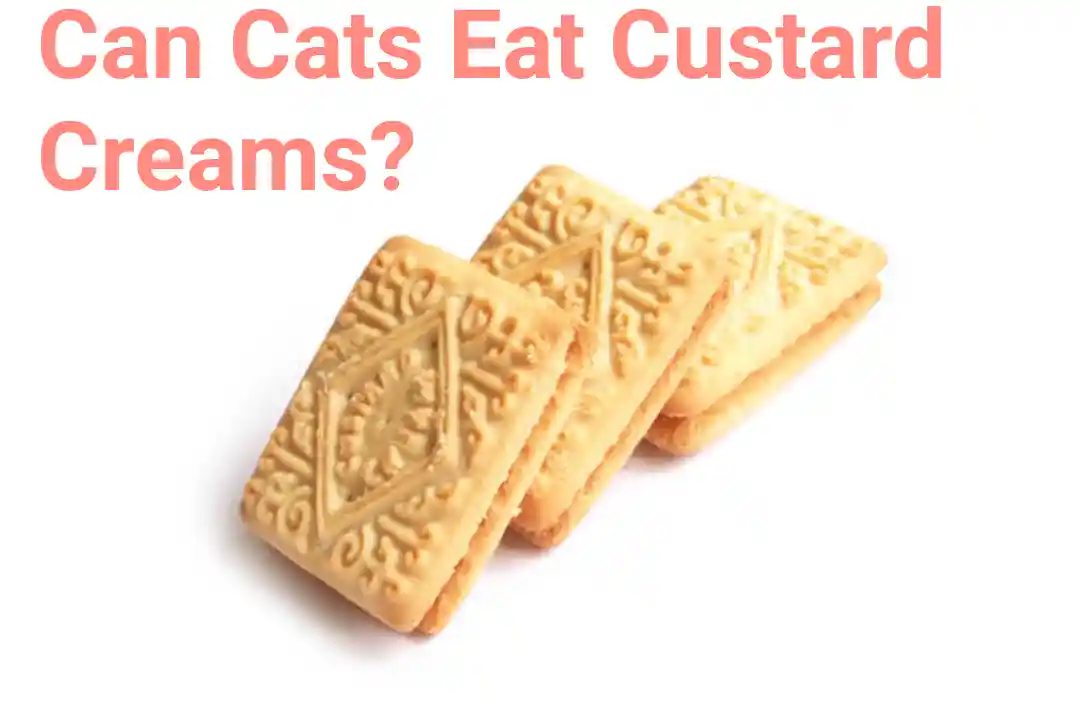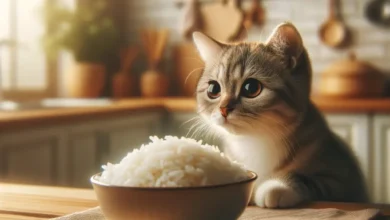Can Cats Eat Custard Creams? 6 Reasons It Should Not Be a Good Idea

Can cats eat custard creams? The smell of freshly-baked custard cream biscuits wafting through the house can be a temptation for cats, but can cats eat custard cream?
When It comes to treats for cats, we are not looking at supplementing their taurine at this point, because, we just want to play with them or get them to participate in routines or training. Custard cream for cats is not a good idea, since it contains lots of sugar and high-calorie content–making it easy to surpass your cat’s daily calorie and sugar quota–which could lead to obesity or diabetes.
In this article, we’ll take a closer look at whether cats can eat custard cream biscuits and the potential risks of doing so. Read on to find out more.
Table of Contents
- What are Custard Creams?
- Can cats eat custard creams?
- Reasons Why You Should Not Feed Cats Custard Creams
- Alternative Healthy Treats to custard cream for Cats
- Can Cats Eat Custard Creams?
What are Custard Creams?
Custard Creams are a classic British biscuit, made up of two crunchy, vanilla-flavored shortbread biscuits with a creamy custard-flavored filling in the middle. The biscuits are a favorite among the British population and are often served with tea or coffee.
The traditional recipe of Custard Creams was first created in the late 19th century by biscuit manufacturer Huntley & Palmers. The distinctive design of the Custard Creams, with their two-tone color and pattern, is believed to have been created by the company’s chief biscuit maker, William Salter.
Custard Creams are made using a combination of flour, sugar, butter, and a unique blend of custard powder. The biscuits are then baked and coated in white chocolate or vanilla icing. They are popularly eaten as a snack or as part of a dessert.
Custard Creams have a long history of being a popular snack or treat. In the 1950s, the biscuit was heavily featured in British TV advertisements, and the popularity of the biscuits continues to this day. They are often served with tea or coffee at social events and can be found in many convenience stores and supermarkets.
Although Custard Creams are a classic British biscuit, they can also be found in other countries, such as Australia and New Zealand. The recipe and ingredients used in these countries may be slightly different, but the overall flavor and texture remain the same.
Can cats eat custard creams?
Cats are curious creatures, and it’s no surprise that they’re often tempted to try different human foods. But should we let our feline friends partake in these delicious treats?
Cats should not eat custard creams. While cats may be tempted by the sweet taste and smell of custard creams, these cookies are not suitable for cats.
Custard creams contain several ingredients that are toxic to cats. The most dangerous ingredient is sugar. Cats are not able to digest sugar properly and it can cause a range of medical issues. Additionally, custard creams contain butter, and flour, all of which can cause digestive issues in cats if ingested.
Cats also cannot digest dairy products, such as the butter found in custard creams. Dairy can cause vomiting, diarrhea, and other digestive issues in cats. It can also lead to an upset stomach and gas.
In addition to the ingredients that can be hazardous to cats, custard creams also contain a lot of fat. Cats are obligate carnivores, meaning they require a diet that is high in protein and low in fat. Eating too much fat can lead to obesity, which can cause a range of health issues in cats.
Reasons Why You Should Not Feed Cats Custard Creams
Custard creams may seem like an innocent treat for cats, but in reality, they’re far from it. Here are some of the reasons why you should not feed your cats custard creams:
1. Too Much Sugar: Custard creams are packed with sugar, which can cause obesity, diabetes, and other health issues in cats. This is especially true when cats consume too much sugar, which can be easy to do when they’re given custard creams.
Sugar can also lead to behavioral issues. Cats that eat too much sugar can become hyperactive and agitated, leading to behavioral problems. This is because sugar can cause a sudden rush of energy and excitement, followed by a crash. While this might be fun for us, it can lead to some serious issues for cats.
2. Lack of Nutrients: Custard creams are low in essential vitamins and minerals that cats need to stay healthy. Without proper nutrition, cats can develop nutrient deficiencies, which can lead to health problems.
3. Potential Allergens: Custard creams can contain several ingredients that may be potential allergens to cats. These include milk, eggs, and wheat, all of which are common allergens in cats.
4. Unhealthy Fats: Custard creams are high in unhealthy fats, which can put a strain on your cat’s liver and lead to other health problems.
5. Poor Digestibility: Custard creams are difficult to digest and can cause upset stomachs and intestinal discomfort in cats.
Alternative Healthy Treats to custard cream for Cats
As pet owners, we all want to give our cats the best care and nutrition possible. A great way to do this is by giving them healthy treats.
One great alternative to custard cream is freeze-dried meat treats. These treats are made from real, single-source animal protein, making them an excellent source of nutrition for your kitty. Plus, cats love the crunchy texture. You can find freeze-dried chicken, beef, and fish treats, so your cat can switch up her snacks.
If your cat is a fan of fish, another great alternative to custard cream is freeze-dried krill treats. Krill is an excellent source of omega-3 fatty acids, which are essential for cats’ health. Plus, cats love the flavor of krill. This is a great way to give your cat a tasty treat while also providing her with the essential nutrients she needs.
Cats also love the taste of catnip, and you can give them a tasty treat without worrying about sugar or other unhealthy ingredients by giving them freeze-dried catnip treats. Not only is catnip an excellent source of vitamins and minerals, but it’s also a natural mood enhancer that can help cats relax and reduce stress.
Another great alternative to custard cream is freeze-dried liver treats. The liver is an excellent source of protein and other essential nutrients for cats, and cats love the rich, savory taste. Plus, freeze-dried liver treats are packed with flavor and won’t spoil as quickly as wet food.
If you’re looking for something a little sweeter, try freeze-dried fruit treats. Freeze-dried fruit is an excellent source of vitamins and minerals, and cats love the sweet taste. You can find freeze-dried apple, banana, and mango treats, which are sure to please your kitty’s taste buds.
If you’re looking for a healthy treat that’s a little more indulgent, try freeze-dried yogurt treats. Yogurt is a great source of probiotics, which can help with digestion and help boost your cat’s immune system. Plus, cats love the creamy texture and taste of yogurt.
There are plenty of alternative treats out there that are healthier than custard cream. With a little bit of research, you can find healthy treats that will make your cat happy and healthy. Give your kitty a tasty treat and get the peace of mind that comes from knowing she’s getting the nutrition she needs.
Can Cats Eat Custard Creams?
Cats are obligate carnivores, which means that they require animal protein to survive. While there are some plant-based proteins that cats can digest, dairy isn’t one of them.
That means that foods like custard creams—which are high in dairy—aren’t good for your cat. They can even be harmful, leading to digestive problems and obesity
In conclusion, cats should not eat custard creams. Not only can the ingredients in custard creams be toxic to cats, but they also contain a lot of fat, which can be harmful to cats. If you want to give your cat a special treat, opt for a commercial cat treat that is specifically designed for cats.




